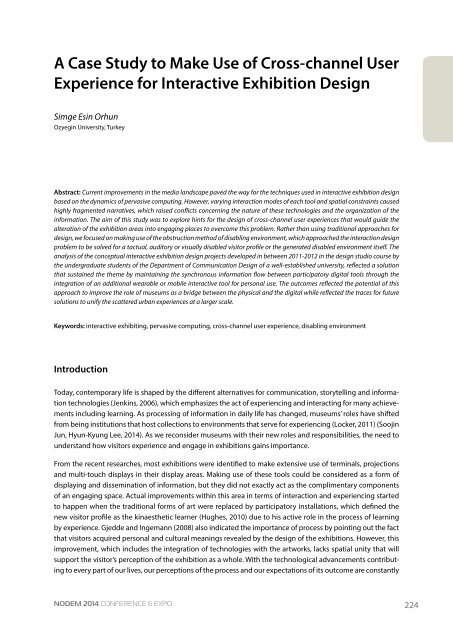NODEM 2014 Proceedings
NODEM 2014 Proceedings
NODEM 2014 Proceedings
Create successful ePaper yourself
Turn your PDF publications into a flip-book with our unique Google optimized e-Paper software.
A Case Study to Make Use of Cross-channel User<br />
Experience for Interactive Exhibition Design<br />
Simge Esin Orhun<br />
Ozyegin University, Turkey<br />
Abstract: Current improvements in the media landscape paved the way for the techniques used in interactive exhibition design<br />
based on the dynamics of pervasive computing. However, varying interaction modes of each tool and spatial constraints caused<br />
highly fragmented narratives, which raised conflicts concerning the nature of these technologies and the organization of the<br />
information. The aim of this study was to explore hints for the design of cross-channel user experiences that would guide the<br />
alteration of the exhibition areas into engaging places to overcome this problem. Rather than using traditional approaches for<br />
design, we focused on making use of the obstruction method of disabling environment, which approached the interaction design<br />
problem to be solved for a tactual, auditory or visually disabled visitor profile or the generated disabled environment itself. The<br />
analysis of the conceptual interactive exhibition design projects developed in between 2011-2012 in the design studio course by<br />
the undergraduate students of the Department of Communication Design of a well-established university, reflected a solution<br />
that sustained the theme by maintaining the synchronous information flow between participatory digital tools through the<br />
integration of an additional wearable or mobile interactive tool for personal use. The outcomes reflected the potential of this<br />
approach to improve the role of museums as a bridge between the physical and the digital while reflected the traces for future<br />
solutions to unify the scattered urban experiences at a larger scale.<br />
Keywords: interactive exhibiting, pervasive computing, cross-channel user experience, disabling environment<br />
Introduction<br />
Today, contemporary life is shaped by the different alternatives for communication, storytelling and information<br />
technologies (Jenkins, 2006), which emphasizes the act of experiencing and interacting for many achievements<br />
including learning. As processing of information in daily life has changed, museums’ roles have shifted<br />
from being institutions that host collections to environments that serve for experiencing (Locker, 2011) (Soojin<br />
Jun, Hyun-Kyung Lee, <strong>2014</strong>). As we reconsider museums with their new roles and responsibilities, the need to<br />
understand how visitors experience and engage in exhibitions gains importance.<br />
From the recent researches, most exhibitions were identified to make extensive use of terminals, projections<br />
and multi-touch displays in their display areas. Making use of these tools could be considered as a form of<br />
displaying and dissemination of information, but they did not exactly act as the complimentary components<br />
of an engaging space. Actual improvements within this area in terms of interaction and experiencing started<br />
to happen when the traditional forms of art were replaced by participatory installations, which defined the<br />
new visitor profile as the kinaesthetic learner (Hughes, 2010) due to his active role in the process of learning<br />
by experience. Gjedde and Ingemann (2008) also indicated the importance of process by pointing out the fact<br />
that visitors acquired personal and cultural meanings revealed by the design of the exhibitions. However, this<br />
improvement, which includes the integration of technologies with the artworks, lacks spatial unity that will<br />
support the visitor’s perception of the exhibition as a whole. With the technological advancements contributing<br />
to every part of our lives, our perceptions of the process and our expectations of its outcome are constantly<br />
<strong>NODEM</strong> <strong>2014</strong> Conference & Expo<br />
224


